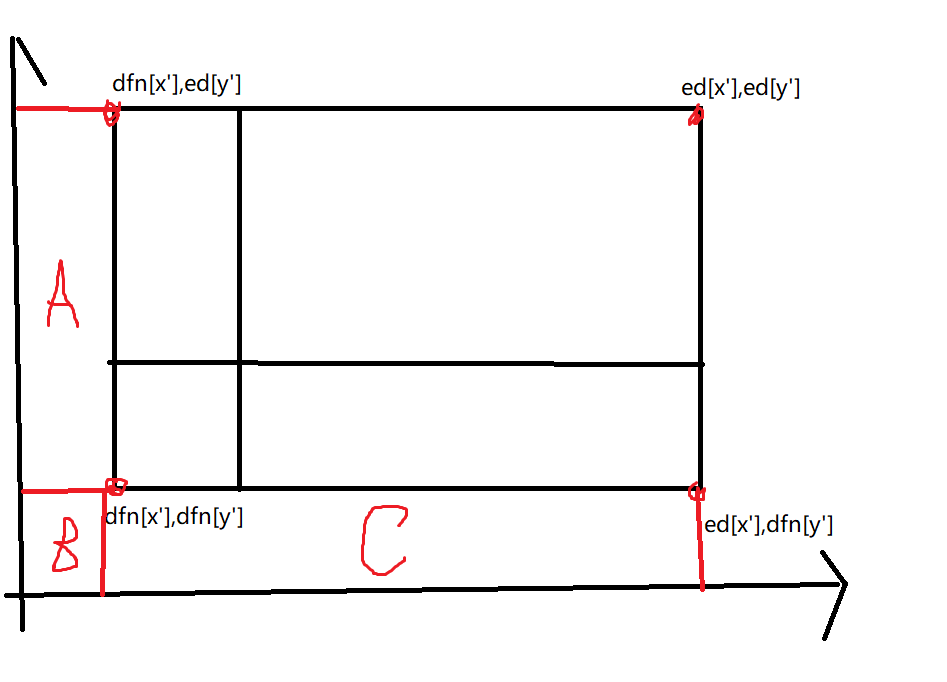闲扯
先看看了B组,T1 ZROI刚好讲过一个性质原根一般很小的,直接枚举;T2一眼二分然后似乎状压 T3没看
然后上来A组题,T1 flow这名字…网络流?!
T1题面非常的社会主义核心价值观,看到有个$m==n$的限制就想如果去掉怎么样,发现一棵树的话答案是确定的,然后考虑加上那条多出来的边,发现答案还是不变的?!想了想好像确实是这样,你树边确定了环边根本不用管,判断有无解就是点值加起来是否为0.于是直接DFS扫一遍去掉环边再DFS一遍就好了
T2 题面1984还行 出题人小心啊 扫了一眼觉得好难告辞
T3 第一眼题面 woc!!求求你们给国家省点子弹,我觉得博客中贴出这题题面的也要被查睡标了
第二眼woc?!这不是雅礼集训讲过的原题吗?!还记得点思路就是预处理坐几班车最远可到达的地方,讲题人还提到了长链剖分
于是肛肛肛…结果死活没调出来…然后xxzh巨佬讲了一种更好写的暴力….感觉以后考试看到原题还是得想想有没有其他的思路
结果15+0+0 T1 TM 正负号打反了,又犯SB错误 心态崩了
T1 flow
分析
某div 2 F竟这么水(你还不是挂分了)
见闲扯
代码
1
2
3
4
5
6
7
8
9
10
11
12
13
14
15
16
17
18
19
20
21
22
23
24
25
26
27
28
29
30
31
32
33
34
35
36
37
38
39
40
41
42
43
44
45
46
47
48
49
50
51
52
53
54
55
56
57
58
59
60
61
62
63
64
65
66
67
68
69
70
71
72
73
74
75
76
77
78
79
80
81
82
83
84
85
86
87
88
89
90
91
92
93
94
95
96
97
98
99
100
101
102
103
104
105
106
107
108
109
110
111
112
113
114
115
116
117
118
119
|
inline char gc(){
static char buf[SIZE],*p1=buf,*p2=buf;
return p1==p2&&(p2=(p1=buf)+fread(buf,1,SIZE,stdin),p1==p2)?EOF:*p1++;
}
#define gc getchar
template <class T>inline void read(T &x){
x=0;int ne=0;char c;
while((c=gc())>'9'||c<'0')ne=c=='-';x=c-48;
while((c=gc())>='0'&&c<='9')x=(x<<3)+(x<<1)+c-48;x=ne?-x:x;return ;
}
const int maxn=200005;
const int inf=0x7fffffff;
struct Edge{
int ne,to,id;
bool ok;
}edge[maxn<<2];
int h[maxn],num_edge=1;
inline void add_edge(int f,int to,int id){
edge[++num_edge].ne=h[f];
edge[num_edge].to=to;
edge[num_edge].id=id;
edge[num_edge].ok=0;
h[f]=num_edge;
}
int w[maxn];
struct Nico{
int x,y,id,dis;
}nico[maxn<<2];
struct QAQ{
int x,y,fff;
int xd,yd;
}yyy[maxn<<2];
int tot=0;
int n,m;
namespace fake{
ll ans=0;
bool vis[maxn];
int fa[maxn];
void gao_cyc(int now){
int v;
vis[now]=1;
for(ri i=h[now];i;i=edge[i].ne){
v=edge[i].to;
if(v==fa[now])continue;
if(vis[v]){
edge[i].ok=edge[i^1].ok=1;
}
if(edge[i].ok)continue;
fa[v]=now;
gao_cyc(v);
}
return ;
}
void get_ans(int now){
int v,id=0;
for(ri i=h[now];i;i=edge[i].ne){
v=edge[i].to;
if(edge[i].ok)continue;
if(v==fa[now]){
id=edge[i].id;continue;
}
get_ans(v);
}
yyy[++tot].x=now,yyy[tot].y=fa[now];
yyy[tot].xd=-w[now],yyy[tot].yd=w[now];
yyy[tot].fff=id;
w[fa[now]]+=w[now];
return ;
}
void main(){
int x,y,a,b;
for(ri i=1;i<=n;i++){
ans+=w[i];
}
memset(vis,0,sizeof(vis));
if(ans==0)puts("Possible");
else{
puts("Impossible");
return ;
}
fa[1]=0;
gao_cyc(1);
get_ans(1);
for(ri i=1;i<=tot;i++){
x=yyy[i].x,y=yyy[i].y;
a=nico[yyy[i].fff].x,b=nico[yyy[i].fff].y;
if(x==a&&y==b){
nico[yyy[i].fff].dis=-yyy[i].xd;
}
else if(x==b&&y==a){
nico[yyy[i].fff].dis=-yyy[i].yd;
}
}
for(ri i=1;i<=m;i++){
printf("%d\n",-nico[i].dis);
}
return ;
}
}
int main(){
int x,y;
FO(flow);
read(n);
for(ri i=1;i<=n;i++)read(w[i]);
read(m);
for(ri i=1;i<=m;i++){
read(x),read(y);
add_edge(x,y,i);
add_edge(y,x,i);
nico[i].x=x,nico[i].y=y,nico[i].dis=0;
}
fake::main();
return 0;
}
|
T2 moon
咕
T3 car
预处理每个点在一条链上坐$2^j$次车最远到哪里,这显然可以倍增搞
然后考虑答案怎么算
对于询问$(x,y)$,求出$z=lca(x,y)$,$x,y$先分别跳到距$z$最近的点(也就是下次就到$z$或更远),这时候先统计个答案步数$ans$
然后发现答案只有两种情况
Case#1
两点分别跳一次到$z$,最终$ans=ans+2$
Case#2
设这时候$x,y$分别跳到了$x’,y’$
有一班车覆盖了路径$(x’,y’)$,那么答案就是$ans=ans+1$,因为你只要坐这班车就可以越过LCA到另一个点
考虑怎么判断有没有一班车覆盖这条路径,转化一下变成是否有一班车$(st,ed)$,$st$在$x’$子树中,$ed$在$y’$子树中(包括$x’.y’$)
如果你看过https://rye-catcher.github.io/2018/10/17/JZOI100019-A-dfs%E5%BA%8F-%E6%89%AB%E6%8F%8F%E7%BA%BF/
就会发现这还可以继续转化成$dfn[x’]<=dfn[st]<=ed[x’],dfn[y’]<=dfn[ed]<=ed[y’]$
将$(dfn[st],dfn[ed])$看成一个坐标,发现就是判断一个矩形中有没有点
似乎可以在线主席树做,也好像可以二分套二分,这里学到了一个新操作树状数组+扫描线+二维前缀和
我们转化后询问$(x’,y’)$矩形的四个坐标为$(dfn[x’],dfn[y’]),(dfn[x’],ed[y’]),(ed[x’],dfn[y’]),(ed[x’],ed[y’])$
一条班车路径转化成一个点$(dfn[st],dfn[ed])$
我们把这些点放在一起按照扫描线思路,将点按横坐标进行排序,然后遍历所有点(优先遍历班车路径转化后的点)
如果是班车路径的点,加入树状数组$[1,dfn[ed]]$($dfn[ed]$其实就是坐标(x,y)中的$y$)前缀和
如果是个矩形想要查询里面点数咋办?二维前缀和.

我们是将所有点按横坐标排序的,所以我们可以先加上$B$的点数,减去$A+B$的点数,然后等到$ed[x’]$坐标时减去$B+C$ 点数,最后加上整个大面积就是矩形内点数
显然这些部分直接查询树状数组前缀和就好了
然后有非常多的细节,见代码注释吧…
对于树上路径,我们都默认dfs序小的为起点方便处理,也算是个技巧
1
2
3
4
5
6
7
8
9
10
11
12
13
14
15
16
17
18
19
20
21
22
23
24
25
26
27
28
29
30
31
32
33
34
35
36
37
38
39
40
41
42
43
44
45
46
47
48
49
50
51
52
53
54
55
56
57
58
59
60
61
62
63
64
65
66
67
68
69
70
71
72
73
74
75
76
77
78
79
80
81
82
83
84
85
86
87
88
89
90
91
92
93
94
95
96
97
98
99
100
101
102
103
104
105
106
107
108
109
110
111
112
113
114
115
116
117
118
119
120
121
122
123
124
125
126
127
128
129
130
131
132
133
134
135
136
137
138
139
140
141
142
143
144
145
146
147
148
149
150
151
152
153
154
155
156
157
158
159
160
161
162
163
164
165
166
167
168
169
170
171
172
173
|
inline char gc(){
static char buf[SIZE],*p1=buf,*p2=buf;
return p1==p2&&(p2=(p1=buf)+fread(buf,1,SIZE,stdin),p1==p2)?EOF:*p1++;
}
template <class T>inline void read(T &x){
x=0;int ne=0;char c;
while((c=gc())>'9'||c<'0')ne=c=='-';x=c-48;
while((c=gc())>='0'&&c<='9')x=(x<<3)+(x<<1)+c-48;x=ne?-x:x;return ;
}
const int maxn=500005;
const int inf=0x7fffffff;
int n,m,q;
struct Edge{
int ne,to;
}edge[maxn<<1];
int h[maxn],num_edge=1;
inline void add_edge(int f,int to){
edge[++num_edge].ne=h[f];
edge[num_edge].to=to;
h[f]=num_edge;
}
int f[maxn][23];
int dep[maxn],fa[maxn],son[maxn],size[maxn],top[maxn],dfn[maxn],ed[maxn],tot=0;
void dfs_1(int now){
int v;size[now]=1;
for(ri i=h[now];i;i=edge[i].ne){
v=edge[i].to;
if(v==fa[now])continue;
dep[v]=dep[now]+1,fa[v]=now;
dfs_1(v);
size[now]+=size[v];
if(!son[now]||size[v]>size[son[now]])son[now]=v;
}
return ;
}
void dfs_2(int now,int t){
int v;
dfn[now]=++tot,top[now]=t;
if(!son[now]){
ed[now]=tot;
return ;
}
dfs_2(son[now],t);
for(ri i=h[now];i;i=edge[i].ne){
v=edge[i].to;
if(v==fa[now]||v==son[now])continue;
dfs_2(v,v);
}
ed[now]=tot;
return ;
}
inline int get_lca(int x,int y){
int xx=x,yy=y;
while(top[x]!=top[y]){
if(dep[top[x]]<dep[top[y]])std::swap(x,y);
x=fa[top[x]];
}
if(dep[x]>dep[y])return y;
return x;
}
void pre_dfs(int now){
int v;
for(ri i=h[now];i;i=edge[i].ne){
v=edge[i].to;
if(v==fa[now])continue;
pre_dfs(v);
if(!f[now][0]||(f[v][0]&&dep[f[now][0]]>dep[f[v][0]]))f[now][0]=f[v][0];
}
return ;
}
struct Seg{
int x,y,id,d;
bool operator <(const Seg &rhs)const{
return (x==rhs.x)?id<rhs.id:x<rhs.x;
}
}seg[maxn<<2];
int sum[maxn<<2];
inline void update(int x,int k){for(;x<=n;x+=x&(-x))sum[x]+=k;}
inline int query(int x){
int tmp=0;
for(;x>=1;x-=x&(-x))tmp+=sum[x];
return tmp;
}
int fac[maxn],ans[maxn];
int qwq=0,pt[maxn];
int main(){
int x,y,lca;
read(n);
fa[1]=0;
f[1][0]=1;
for(ri i=2;i<=n;i++){
f[i][0]=i;
read(fa[i]);
add_edge(i,fa[i]),add_edge(fa[i],i);
}
dep[1]=0;
dfs_1(1);
dfs_2(1,1);
read(m);
for(ri i=1;i<=m;i++){
read(x),read(y);
if(dfn[x]>dfn[y])std::swap(x,y);
lca=get_lca(x,y);
if(!f[x][0]||dep[f[x][0]]>dep[lca])f[x][0]=lca;
if(!f[y][0]||dep[f[y][0]]>dep[lca])f[y][0]=lca;
seg[++qwq]=(Seg){dfn[x],dfn[y],0,1};
}
pre_dfs(1);
fac[0]=1;
for(ri i=1;i<=n;i++)if(f[i][0]==i){
f[i][0]=0;
}
for(ri k=1;k<=21;k++){
fac[k]=(fac[k-1]<<1);
for(ri i=1;i<=n;i++)f[i][k]=f[f[i][k-1]][k-1];
}
int po,qo;
read(q);
for(ri o=1;o<=q;o++){
read(x),read(y);
if(dfn[x]>dfn[y])std::swap(x,y);
lca=get_lca(x,y);
po=x,qo=y;
for(ri i=21;i>=0;i--)
if(dep[f[po][i]]>dep[lca]){
po=f[po][i];
ans[o]+=fac[i];
}
for(ri i=21;i>=0;i--)
if(dep[f[qo][i]]>dep[lca]){
qo=f[qo][i];
ans[o]+=fac[i];
}
if((!f[po][0]&&po!=lca)||(!f[qo][0]&&qo!=lca)){
ans[o]=-1;
}
else {
if(po==lca||qo==lca){
ans[o]++;
}
else {
ans[o]+=2;
seg[++qwq]=(Seg){dfn[po]-1,dfn[qo]-1,o,1};
seg[++qwq]=(Seg){ed[po],ed[qo],o,1};
seg[++qwq]=(Seg){dfn[po]-1,ed[qo],o,-1};
seg[++qwq]=(Seg){ed[po],dfn[qo]-1,o,-1};
}
}
}
std::sort(seg+1,seg+1+qwq);
for(ri i=1;i<=qwq;i++){
if(!seg[i].id){
update(seg[i].y,seg[i].d);
}
else{
pt[seg[i].id]+=seg[i].d*query(seg[i].y);
}
}
for(ri i=1;i<=q;i++){
if(pt[i])printf("%d\n",ans[i]-1);
else printf("%d\n",ans[i]);
}
return 0;
}
|
